Related Research Articles

East Turkestan or East Turkistan, also called Uyghuristan, is a loosely-defined geographical region in the northwestern part of the People's Republic of China, which varies in meaning by context and usage. The term was coined in the 19th century by Russian Turkologists, including Nikita Bichurin, who intended the name to replace the common Western term for the region, "Chinese Turkestan", which referred to the Tarim Basin in Southern Xinjiang or Xinjiang as a whole during the Qing dynasty. Beginning in the 17th century, Altishahr, which means "Six Cities" in Uyghur, became the Uyghur name for the Tarim Basin. Uyghurs also called the Tarim Basin "Yettishar," which means "Seven Cities," and even "Sekkizshahr", which means "Eight Cities" in Uyghur. Chinese dynasties from the Han dynasty to the Tang dynasty had called an overlapping area the "Western Regions".

Aksu is a city in and the seat of Aksu Prefecture, Xinjiang, lying at the northern edge of the Tarim Basin. The name Aksu literally means "white water" and is used for both the oasis town and the Aksu River.
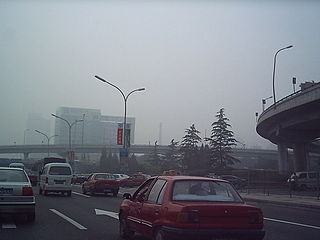
Madian is a community in Haidian District, northern Beijing. It is adjacent to the intersection of the 3rd Ring Road and the Badaling Expressway, at the Haidian District-Xicheng District border. Two separate street administrative offices serve portions of Madian.

Hami or Kumul is a prefecture-level city in eastern Xinjiang, China. It is well known for sweet Hami melons. In early 2016, the former Hami county-level city merged with Hami Prefecture to form the Hami prefecture-level city with the county-level city becoming Yizhou District. Since the Han dynasty, Hami has been known for its production of agricultural products and raw resources.

Wujiaqu is a county-level city in the northern part of Xinjiang Uyghur Autonomous Region, China, about 40 kilometres (25 mi) north of Ürümqi.

Xinjiang is historically consisted of two main geographically, historically, and ethnically distinct regions with different historical names: Dzungaria north of the Tianshan Mountains; and the Tarim Basin south of the Tianshan Mountains, currently mainly inhabited by the Uyghurs. They were conquered by the Qing dynasty in the 18th century, and after the Dungan Revolt (1862–1877) the Qing reconquered both regions and integrated them into one province named Xinjiang in 1884.
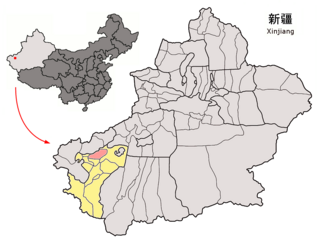
Payzawat County, also via SASM/GNC romanization as Payziwat County, and via Mandarin Chinese as Jiashi County is a county in Kashgar Prefecture, Xinjiang Uyghur Autonomous Region, China, on the western rim of the Taklamakan Desert. To the east, the county borders Maralbexi County, to the south Yopurga County.

Shufu County, also transliterated from Uyghur as Konaxahar County or Konasheher County/Kona Sheher County, is a county in Kashgar Prefecture, Xinjiang Uyghur Autonomous Region, China. It contains an area of 3,513 km2 (1,356 sq mi). According to the 2002 census, it has a population of 360,000.

Toksun County is a county in Turpan, Xinjiang Uyghur Autonomous Region, China.
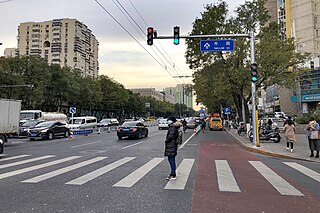
Niujie is a subdistrict in Xicheng District in southwest Beijing, China. The name "Niujie" can refer to the street Niujie or to the neighborhood Niujie. The subdistrict was previously in Xuanwu District before the district was merged into Xicheng District in 2010. As of 2020, its total population is 51,410.

Xinjiang, officially the Xinjiang Uygur Autonomous Region, is an autonomous region of the People's Republic of China (PRC), located in the northwest of the country at the crossroads of Central Asia and East Asia. Being the largest province-level division of China by area and the 8th-largest country subdivision in the world, Xinjiang spans over 1.6 million square kilometres (620,000 sq mi) and has about 25 million inhabitants. Xinjiang borders the countries of Afghanistan, Kazakhstan, Kyrgyzstan, Mongolia, Pakistan, Russia, Tajikistan, and India. The rugged Karakoram, Kunlun and Tian Shan mountain ranges occupy much of Xinjiang's borders, as well as its western and southern regions. The Aksai Chin and Trans-Karakoram Tract regions are administered by China but also claimed by India. Xinjiang also borders the Tibet Autonomous Region and the provinces of Gansu and Qinghai. The most well-known route of the historic Silk Road ran through the territory from the east to its northwestern border.

Ganjiakou Subdistrict is a subdistrict of Haidian District, Beijing, It borders Zizhuyuan and Beixiaguan Subdistricts in the north, Zhanlan Road and Yuetan Subdistrict in the east, Yangfangdian Subdistrict in the south, and Balizhuang Subdistrict in the west. As of 2020, its population was 117,946.
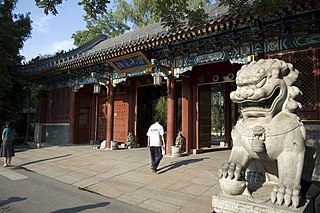
Yanyuan Subdistrict is a subdistrict of Haidian District, Beijing, It borders Qinghuayuan Subdistrict to its northeast, Zhongguancun Subdistrict to its southeast, Wanliu Area and Haidian Subdistrict to its south, and Qinglongqiao Subdistrict to its northwest. In 2020, it had a total population of 29,779.
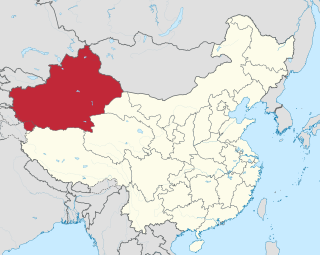
The Xinjiang conflict, also known as the East Turkistan conflict, Uyghur–Chinese conflict or Sino-East Turkistan conflict, is an ongoing ethnic geopolitical conflict in what is now China's far-northwest autonomous region of Xinjiang, also known as East Turkistan. It is centred around the Uyghurs, a Turkic ethnic group who constitute a plurality of the region's population.
Xinjiangcun or Xinjiang Village was an ethnic enclave of Uyghur people in the Ganjiakou and Weigongcun areas in Haidian District, Beijing. The Beijing government demolished the settlement in 1999. It is in proximity to a historical Uyghur enclave in Beijing.

Beijing has a large community of Hui people, totaling 249,223 people per the 2010 Chinese Census, or 2.35% of the city's total population. As of 2010, the Hui are the second largest minority in the city, behind the Manchu. Neighborhoods with high concentrations of Hui people, such as Niujie, exist throughout the city.
The registered population of Beijing Municipality consists of people holding either Beijing permanent residence hukou permits or temporary residence permits. The 2010 census revealed that the official total population in Beijing was 19,612,368, representing a 44% increase over the last decade. In 2006, the population of the urban core was 13.33 million, 84.3 percent of the total municipal population, which officially stood at 15.81 million. Urban sprawl continues at a rapid pace.

The 2010 census put Shanghai's total population at 23,019,148, a growth of 37.53% from 16,737,734 in 2000. 20.6 million of the total population, or 89.3%, are urban, and 2.5 million (10.7%) are rural. Based on population of total administrative area, Shanghai is the second largest of the four direct-controlled municipalities of China, behind Chongqing, but is generally considered the largest Chinese city because Chongqing's urban population is much smaller.

Migration to Xinjiang is both an ongoing and historical movement of people, often sponsored by various states who controlled the region, including the Han dynasty, Qing dynasty, Republic of China and People's Republic of China.

Yangfangdian Subdistrict is a subdistrict situated on the southern end of Haidian District, Beijing, China. It borders Ganjiakou and Balizhuang Subdistricts to the north, Yuetan Subdistrict to the east, Guang'anmenwai Subdistrict and Fengtai District to the south, and Wanshou Road Subdistrict to the west. Its population was 120,302 as of the year 2020.
References
- Baranovitch, Nimrod (University of Haifa). "Inverted Exile: Uyghur Writers and Artists in Beijing and the Political Implications of Their Work." Modern China . SAGE Publications. October 2007 33: 462-504, doi: 10.1177/0097700407304803.
- Kaltman, Blaine. Under the Heel of the Dragon: Islam, Racism, Crime, and the Uighur in China. Ohio University Press, 2007. ISBN 089680254X, 9780896802544.
- Millward, James A. (1998). Beyond the Pass: Economy, Ethnicity, and Empire in Qing Central Asia, 1759-1864 (illustrated ed.). Stanford University Press. ISBN 0804729336 . Retrieved 10 March 2014.